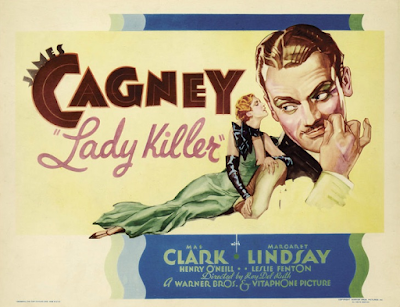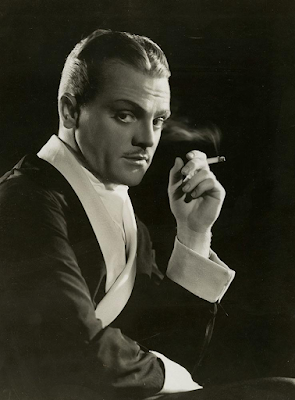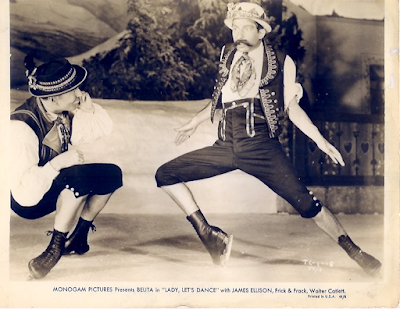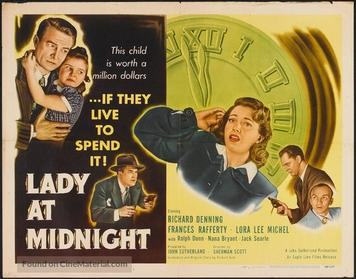Wonderland Burlesque's
Let's All Go To The Movies
She's A Lady!
Part XXIV
Yes, sometimes? It takes a lady.
Or so these films would have us believe.
They promise lots of drama, the occasional comedy or musical, and a little bit of dirt!
Let's take a walk down Hollywood Blvd. and shine a light on these magnificent classic films.
This way, if you please. But remember...
Ladies first!
--- ---
Lady Killer
(1933)
When a movie theater usher is fired, he takes up with criminals and finds himself quite adept at various illegal activities. Eventually though, the police catch up with him, and he runs to hide out in Los Angeles. There he stumbles into the movie business and soon rises to stardom. He's gone straight, but his newfound success catches the attention of his old criminal associates, who promise to keep this latest matinee idol's past a secret... for a price!
When Mae Clarke is reading from the California travel brochure, she gets a worried look on her face when she reads 'Grapefruit'. This is a reference to The Public Enemy (1931), which also stars James Cagney and Clarke, where Cagney's character famously pushes a grapefruit into her face.
The fan mail scam portrayed in this film actually had a real-life precedent. Actor Ivan Lebedeff was cast in several prominent roles by RKO before they realized a majority of the fan mail for him had actually been written by Lebedeff himself.
The film received mixed reviews at the time of its release, as reflected in a collection of excerpts published in The Hollywood Reporter: the World-Telegram called it "a sprightly, more or less daring, thoroughly entertaining film," while less favorable reviewers dismissed it as "premeditated hokum" and "more a collection of jokes than a sustained narrative." Cagney's performance, however, was unanimously praised.
--- ---
Lady Behave!
(1937)
It's bad enough that Clarice Kendall Andrews, Paula's irresponsible sister, comes home from celebrating Mardi Gras and drunkenly mentions that she got married during the festivities. What's worse is the fact that Paula knows that Clarice is still married to an equally irresponsible gigolo! Paula learns that the man Clarice married, Stephen Cormack, has skipped the country and his lawyer, thinking that Paula is Clarice, offers her $5000 to annul the marriage. Paula's lawyer convinces her to pretend she's Clarice until he can get Clarice's first marriage annulled. Paula moves into Cormack's house and discovers he has two teen-aged children who consider her a gold-digger after their father's fortune. Meanwhile, Clarice's gigolo husband refuses to have their marriage annulled and tries to blackmail Paula into giving him to $10,000 to buy his silence.
Released by Republic Pictures, this sophisticated American comedy was directed by Lloyd Corrigan and stars Sally Eilers, Neil Hamilton, and Joseph Schildkraut.
The original script had to be adjusted when PCA (Production Code Administration) Director Joseph Breen questioned the advisability of "dealing with so serious a subject as a bigamous marriage, where the treatment is set for comedy." The Hays Office told Republic Pictures that in these times ladies do not misbehave; the dropping of 'mis' would still give the desired undesirable impression. After the script was altered and the title changed, Breen did approve the film.
Eilers was a popular figure in early-1930s Hollywood, known for her high spirits and vivacity. Her films were mostly comedies and crime melodramas. By the end of the decade, her popularity had waned, and her subsequent film appearances were few. She was married four times, beginning with Western actor Hoot Gibson. She and her second husband, Harry Joe Brown, had one child, a son. She lived in a mansion in Beverly Hills, California designed by architect Paul R. Williams.
Lady, Let's Dance
(1944)
When the lady half of a dancing partnership fails to show up at a hotel where they are booked to appear, entertainment manager James Ellison recruits chambermaid Belita, who is a European dancer who was training for the ice-dancing competition in the Olympics when the Nazis invaded. They quickly fall in love but do nothing about it, since he's busy trying to book her for a major show in Chicago. The two quickly lose contact; he loses his edge, while she rises to become a major star. In the end, he goes off to fight in the war.
Produced by Monogram Studios, this black and white ice skating musical was directed by Frank Woodruff and stars ice skater Belita as herself, James Ellison, and Walter Catlett. It stars It also includes appearances by ice skating artist Myrtle Godfrey and the renowned ice skating comedy team Werner Groebli & Hansruedi Mauch, more commonly known as Frick and Frack.
The film was nominated for two Oscars! Edward Kay's Oscar-nominated score included: Golden Dreams, Silver Shadows, In the Days of Beau Brummel, Ten Million Men and a Girl, Dream of Dreams, Rio, Happy Hearts, Esperanza, and the title song, Lady, Let's Dance.
In the film ice skater Myrtle Godfrey sports the same green bonnet with an ostrich plume worn by Vivien Leigh in Gone with the Wind (1939).

Lady At Midnight
(1948)
A young couple struggles to raise their adopted daughter, but a mysterious murder reveals that the child is heir to a huge fortune. Unfortunately, a greedy lawyer is scheming to steal it.
Shot at the Universal Studios, this American mystery was directed by Sam Newfield and stars Richard Denning, Frances Rafferty, Lora Lee Michel and Claudia Drake.
Lora Lee would marry many times, the first time at the age of seventeen, and was guilty of bigamy at least twice! Typically, the marriages lasted only a matter of weeks. She had two children; the first, she gave up for adoption, the second was born with a fatal birth defect and died the next day.
She came to public attention again in 1963 when she and her third husband were sentenced in federal court for stealing a car and driving it across state lines. After her release from prison, she disappeared. It is believed she died from cancer in 1979.
Lady Beware
(1987)
Filmed on location in and around Pittsburgh, this American thriller was directed by Karen Arthur and stars Diane Lane, Michael Woods and Cotter Smith.
This one had a troubled history. Development for the film began in 1978. By 1986, the film had gone through 17 drafts, eight screenwriters, and been turned down by two studios (Universal and New World).
Director Karen Arthur disowned (and nearly took her name off of) the finished film. Against her wishes, the studio re-edited the film to show more nudity on the part of Diane Lane. In addition, the studio minimized Cotter Smith's performance, and all scenes with Viveca Lindfors were eliminated; both actors played characters integral to the plot, and these eliminations made the film more confusing. Arthur told The Los Angeles Times in 1986 ahead of the film's release: "The purse-holders are men, and they attempted to make Lady Beware into a violent picture. I'm not interested in making a picture where a woman gets beat up. I want to show how a lady deals with this kind of insidious violence. A policeman can't help."
--- ---
And that's all for now, folks!
Tune in next time...
Same place, same channel.
--- ---
Lady Beware - Movie Trailer
(1987)



















































































2 comments:
I LOVE Diane Lane. Love her.
And whoa, Lora Lee! Her life WAS a movie.
XOXO
Wow!!! Look at Diane Lane!!! It's always fun to go back in time like this.
Post a Comment